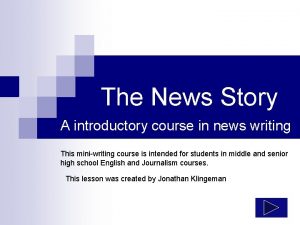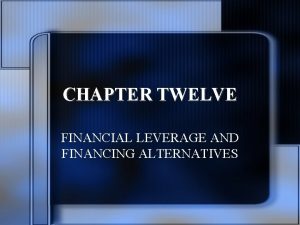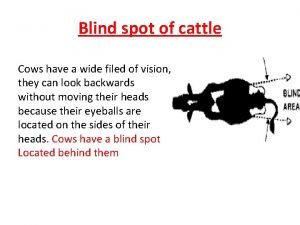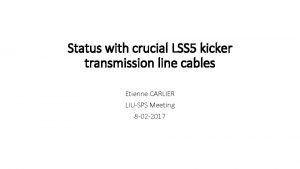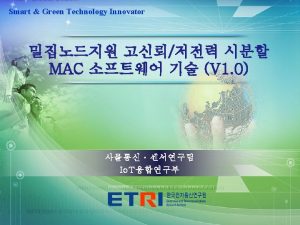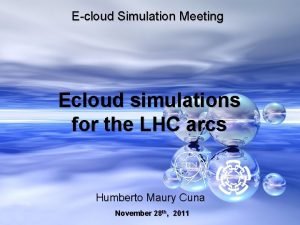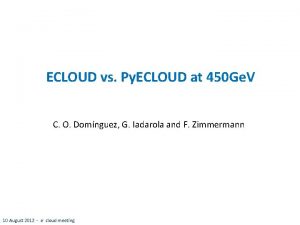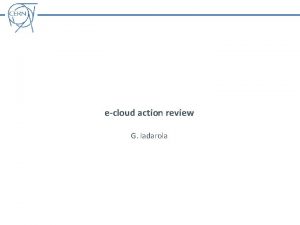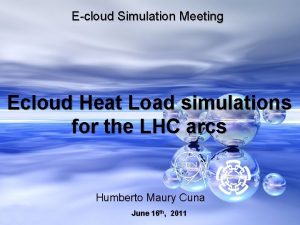Ecloud studies on the SPS slot line kicker







- Slides: 7

E-cloud studies on the SPS slot line kicker A. Romano, G. Iadarola, G. Rumolo Many thanks to: G. Arduini, M. Beck, P. Parrado Caballero A. Romano et al. HSC Section Meeting 1

Slot line kicker 1/2 • In order to meet the beam intensity demands for the HL-LHC upgrade, a wideband intrabunch feedback is desirable in the SPS to control vertical beam instabilities arising from intensity dependent effects (e. g, ECI, TMCI) • The slot line kicker* has been selected as wideband damper to control unstable modes within a bunch Ø promising deflecting structure which meets the system requirements in terms of bandwidth, shunt impedance and beam coupling impedance Ø It will replace ~1. 3 m of standard drift chamber during the next EYETS Profile of the drift chamber (d=156 mm, St. St) Slot line kicker profile (aperture of 132 x 54. 3 mm, St. St) * J. M. Cesarotto et al. , “A WIDEBAND SLOTTED KICKER DESIGN FOR SPS TRANSVERSE INTRA-BUNCH FEEDBACK” A. Romano et al. HSC Section Meeting 2

Slot line kicker 2/2 1106. 3 mm • 40 slots equally spaced along the structure • Each slot is 70 x 12. 5 mm • Slots are placed symmetrically on top and bottom of the chamber Courtesy of P. Parrado Caballero A. Romano et al. HSC Section Meeting 3

Electron cloud buildup simulations 1/2 GOAL of the study: comparing the multipacting thresholds estimated for the two different chambers and for various bunch intensities EC considerations for the latest ECR Simulation setup • SPS nominal beam parameters at injection (26 Ge. V, �� z = 0. 25 m) x, y = 2. 5 um, 4�� • Bunch intensity scanned in the range 1 e 11 -2. 5 e 11 ppb • SEY scanned in the range 1. 0 -1. 9 • Chamber models Ø Old drift chamber circular profile with a 56. 3 m diameter Ø Slotted line kicker uniform chamber having rectangular aperture with dimensions of 132 x 54. 3 mm as preliminary study slots were not included in the model A. Romano et al. HSC Section Meeting 4

Electron cloud buildup simulations 2/2 • For future beam intensities, the new device behaves better in terms of EC buildup larger multipacting thresholds • For current beams it behaves worse lower EC thresholds A. Romano et al. HSC Section Meeting 5

Multipacting thresholds in the SPS: summary table Machine element Fraction of the machine MBA dipole magnet Multipacting threshold (SEY) 1. 0 x 1011 ppb 1. 5 x 1011 ppb 2. 0 x 1011 ppb 2. 5 x 1011 ppb 32. 8 % 1. 60 1. 6 MBB dipole magnet 35. 0 % 1. 35 1. 40 QF quadrupole magnet 4. 8 % 1. 25 1. 30 1. 35 QD quadrupole magnet 4. 8 % 1. 15 1. 05 1. 15 156 -mm drift chamber 4. 1 % 1. 45 1. 30 1. 15 Slotted line kicker 0. 01% 1. 30 1. 25 1. 20 A. Romano et al. HSC Section Meeting 6

Possible response and open questions • According to simulations results, the new slotted line kicker could be affected by strong e-cloud after installation (at least before conditioning) the situation can improve when moving on high intensity beams • If the performance of this device could be limited by the presence of electrons, two possible mitigation strategies can be suggested Ø Coating with low SEY materials attractive solution but we should ask whether it meets project requirements in terms of budget and schedule Ø Weak solenoid satisfactorily suppresses multipacting in the drift –> a magnetic field of few tens of Gauss can efficiently confine electrons near the wall’s surface in the vacuum chamber. • … but in general how this type of request should be handled in the future and what type of recommendation should be given ? Thanks for your attention and feedbacks! A. Romano et al. HSC Section Meeting 7




